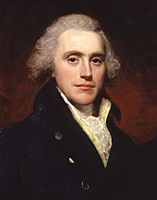Addington ministry facts for kids
Quick facts for kids Addington ministry |
|
|---|---|
 |
|
| 1801–1804 | |

Addington (1803)
|
|
| Date formed | 17 March 1801 |
| Date dissolved | 10 May 1804 |
| People and organisations | |
| Monarch | George III |
| Prime Minister | Henry Addington |
| Total no. of members | 11 appointments |
| Member party | Tory Party |
| Status in legislature | Majority |
| Opposition party | Whig Party |
| Opposition leaders | |
| History | |
| Election(s) |
|
| Legislature term(s) |
|
| Predecessor | First Pitt ministry |
| Successor | Second Pitt ministry |
Henry Addington, a member of the Tory Party, was chosen by King George III to lead the government of the United Kingdom of Great Britain and Ireland. He served as Prime Minister from 1801 to 1804. His time in charge was a short break between two periods when William Pitt the Younger was Prime Minister. Addington's government is most famous for making the Treaty of Amiens. This treaty brought a brief stop to the Napoleonic Wars, a major conflict across Europe.
Who Was in Charge? (Addington's Cabinet)
A "cabinet" is a group of the most important ministers in a government. These ministers help the Prime Minister make big decisions for the country. Here are some of the key people and their jobs in Henry Addington's cabinet:
Leading the Government
- Prime Minister and Finance Minister: Henry Addington himself held two very important roles. He was the First Lord of the Treasury, which is like being the head of the government. He was also the Chancellor of the Exchequer, meaning he was in charge of the country's money and taxes. He held these jobs for his entire time as Prime Minister, from March 1801 to May 1804.
Other Key Ministers
- Chief Legal Advisor: The Lord Chancellor is the most senior judge in the country and a key legal advisor to the government. This role was held by The Lord Eldon.
- Council Leader: The Lord President of the Council leads a group of advisors to the King. This position was first held by The Earl of Chatham and then by The Duke of Portland.
- Keeper of the King's Seal: The Lord Privy Seal is another old and important role, responsible for the King's personal seal. The Earl of Westmorland held this job.
- Home Affairs: The Secretary of State for the Home Department looks after law and order and internal matters within the country. This role saw a few changes: The Duke of Portland started, then The Lord Pelham of Stanmer, and finally Charles Philip Yorke.
- Foreign Affairs: The Secretary of State for Foreign Affairs handles relationships with other countries. The Lord Hawkesbury was in charge of this important area.
- War and Colonies: The Secretary of State for War and the Colonies was responsible for the army and Britain's colonies around the world. This job was held by The Lord Hobart.
- Navy Chief: The First Lord of the Admiralty was the head of the Royal Navy, which was very important during the Napoleonic Wars. The Earl of St Vincent led the navy.
- Military Supplies: The Master-General of the Ordnance was in charge of weapons and military equipment. This role was held by The Earl of Chatham.
- Trade Leader: The President of the Board of Trade looked after the country's business and trade. The Earl of Liverpool held this position.
- India Affairs: The President of the Board of Control oversaw British affairs in India. This role was first held by The Earl of Dartmouth and then by Viscount Castlereagh.

All content from Kiddle encyclopedia articles (including the article images and facts) can be freely used under Attribution-ShareAlike license, unless stated otherwise. Cite this article:
Addington ministry Facts for Kids. Kiddle Encyclopedia.
